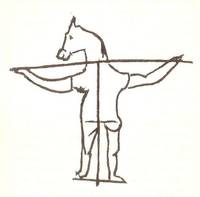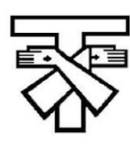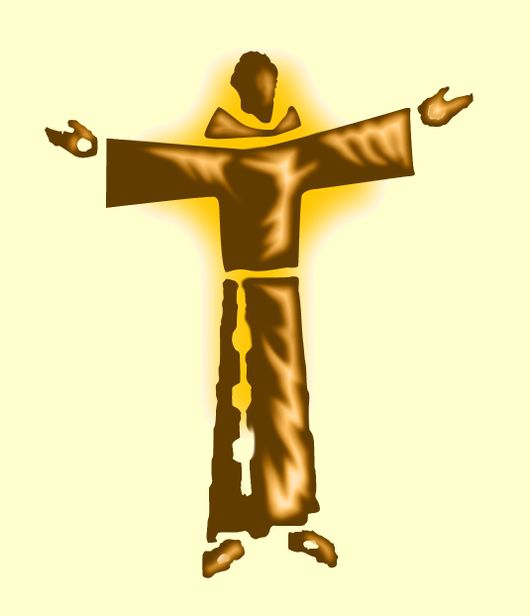What is the significance of the Tau Cross for Franciscans?
This question was asked by a reader who had searched our site in pursuit of information about the Tau cross and had not found any. It is a question we Franciscans are often asked when people catch sight of the Tau cross that we wear, particularly when we are in civilian dress. But it is also surprising how many passers-by on city streets will recognise it and hail us, asking, "Are you a Franciscan?" How has this sign become so universally identified with the Franciscan Order? The answer goes right back to St Francis himself.
The letter TAU occurs in both the Greek and Hebrew alphabets and corresponds to our letter T: in Greek it is the nineteenth letter and shaped very much like our T, whereas in Hebrew it is the twenty-third: that is, the last letter, and has a different shape, but is sometimes represented by a cross. St Francis adopted this sign and used it frequently in his writings, on the walls of places where he stayed, and on himself when he initiated any action. It became his recognised signature on any letters he wrote. St Bonaventure tells us that Francis venerated the TAU and was devoted to it. He spoke of it often and recommended it to his Brothers and signed it with his own hand on his letters. That he marked walls with it is confirmed by archeological findings, and that he signed his letters with it is confirmed by two manuscripts.
The first is his Letter to all Clerics, the original of which is lost but the early copy we have reproduces scrupulously the TAU with which St Francis signed it.
The second is the original autograph of the Blessing of Brother Leo written in his own hand and given to Brother Leo, priest, companion and scribe, after Francis had received the Stigmata at La Verna. Francis told Leo to accept this and keep it until death. Brother Leo himself took care to annotate the document in his own hand to confirm that Francis himself had written the TAU at the foot of the text inserting it in Brother Leo's name: FRATE LEONE. Brother Leo further annotated in red ink in the upper margin the circumstances and fixed the date as two years before the death of Francis. This autograph is now kept in Assisi and often reproduced. The words of the blessing are taken from the Old Testament Book of Numbers (6:24-26).
Old Testament
The use of the TAU as a sacred sign has a surprisingly long history going back to before Christian times. We find it mentioned in the Old Testament, where in the Prophet Ezechiel we read, " Go all through the city, all through Jerusalem, and mark a TAU on the foreheads of all who deplore and disapprove of all the filth practised in it ". The account then makes clear that this sign will save those marked with it. This text was well-known as a subject of preaching in medieval times.
Christians from the beginning used this sign as a form of the cross of Christ. Indeed, in the first centuries it was the only form of the cross they used, a secret sign like the fish. So we find frequent examples of the TAU being used on grave-stones in the catacombs, either before or in the middle of the name of the dead person (see examples below, taken from Fr Herbert Schneider's Leben im Zeichen des Tau ).
There is even an example of the TAU being used in a blasphemous attack on Christian belief, where Christ is represented with the head of a donkey on a cross in the form of a TAU (see right). This is significant in suggesting that the crucifixion may have been carried out with this form of cross, namely an upright post permanently fixed in the ground and a crosspiece carried to the place of execution by the condemned person, which was slotted into the top of the upright.
We may wonder what experience in Saint Francis's life occasioned his great devotion to the TAU cross. There are several possibilities. The first is his contact with the Antonians. Their full title was Hospitaler Brothers of Saint Antony the Hermit and they were active in the care of lepers. We know that the meeting with the leper was a decisive moment in his own conversion and that he desired his followers to live in lazarets in order to serve lepers. Now the Antonians had a lazaret in Rome where it is known that St Francis stayed more than once. He would have noted that the TAU cross was their badge and was sewn onto their habit.
Another influential experience was certainly his presence at the Fourth Lateran Council in 1215, where the Pope was Innocent III who gave approval to the Rule. The Council was opened by Innocent III with a discourse which left a deep impression on those present, including Francis. This discourse culminated in a recalling of the TAU in the Book of Ezekiel and a challenge to his hearers to be champions of the TAU and of the Cross of Christ. It was an appeal to a general mobilisation of the whole of the Christian world in a crusade of conversion and penance.
Francis must also have heard about the Children's Crusade in 1212, whose chosen symbol was the TAU.
We can see, therefore, that the TAU cross was for St Francis a sign of salvation through the Cross of Christ, through penance, and of joy and of victory. St Francis loved to point out to the friars that when they stretched out their arms their habit formed a TAU (see right).
Thomas of Celano, the earliest biographer of St Francis, tells the story of a certain Brother who enjoyed the company of St Francis and who claimed to have seen the great sign of the TAU on the forehead of St Francis.
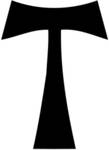
A TAU Cross
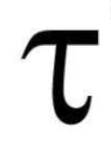
The letter TAU in the Greek alphabet
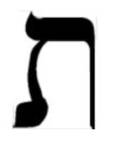
The letter TAU in the Hebrew alphabet
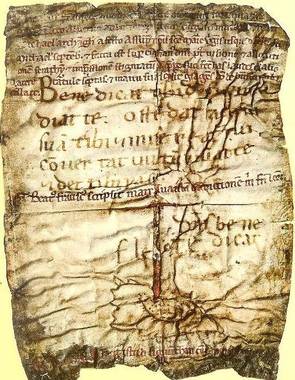
The Blessing of Brother Leo written by St Francis in his own hand and signed with the TAU



Examples of grave-stone inscriptions containing the letter TAU
